Garden Control of Invasive Weeds
Do not let the little blighters get a foot (or root) hold in your garden. Gardeners need to be on their guard when it comes to controlling pernicious weeds as little plants invade quicker than you imagine.
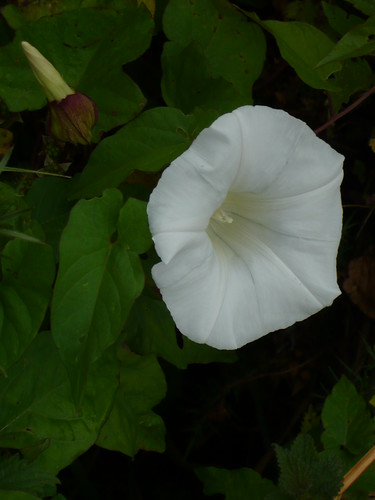
Top Ten Invasive & Pernicious Weeds
- Japanese Knotweed is a big thug – a really big thug! Beware!
- Convolvulus or bindweed (above)that grows as a twining climber and throttles the host.
- Mares (or horses) Tail a plant from the age of fossils, it is so hard to destroy once you have a colony.
- Giant Hogweed Heracleum mantegazzianum is covered by legislation and quite dangerous due to the burning effect of the sap.
- Rosebay Willow Herb once more feared than is now the case see picture below.
- Himilayan Balsam the new plant we love to hate, introduced by Kew gardens in the 1830’s. link
- Thistles of all sorts and varieties if not selected by the gardener
- Brambles particularly the hedgerow varieties with very small fruit and thus no redeeming features.
- Aquatic weeds named by RHS as invasive including New Zealand pygmy weed (Crassula helmsii) and Parrot’s Feather Myriophyllum aquaticum, Fairy fern, Floating pennywort , Nuttall’s pondweed, Curly waterweed and Curled pondweed
- Take your pick from Dandelion, Nettle, Buttercup any plant growing anywhere you didn’t want it to grow. Let us know your view
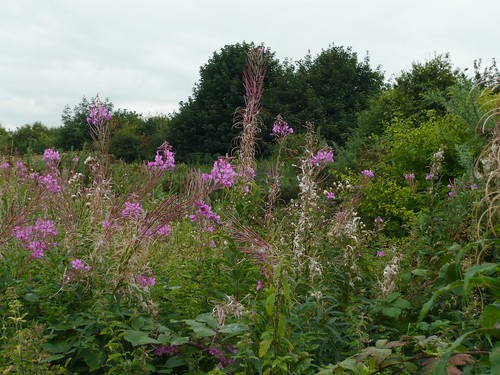 Rosebay-Willow Herb in flower and seed.
Rosebay-Willow Herb in flower and seed.
Tips for Controlling Invasive Weeds
- Prevention is better than cure. Do not let them seed
- Do not take plants or soil from the wild and take care with seed.
- Dig up at the first sign of growth.Dig out all the root and I mean all!
- Do not compost flowers which may contain seeds nor roots.
- Cutting down or digging up weeds and burning the waste plant material are useful, low-tech means of control.
- Pulling up Himalayan balsam before the plants flower is the most effective method of control. Cutting plants down before they flower can result in a more bushy plant that produces even more flowers. Young growth may be more susceptible to weed killers.
- Spraying invasive weeds with herbicide is the most effective form of treatment currently available. It can however take several years to get rid of some invasive species.The effectiveness depends on the type of herbicide used.
- Apply sodium chlorate crystals to the hollow cut stems after cutting back is said to be effective. But be careful as sodium chlorate is highly soluble and any spillage can affect nearby plants.
- Impermeable membranes like black plastic work on most plants by denying light and water. Unfortunately Japanese Hogweed can push through the toughest barrier.
Let us know if you have a fool proof method – this fool needs all the help he can get!
Below Japanese Knot Weed in a clump and a thistle ready with seeds.
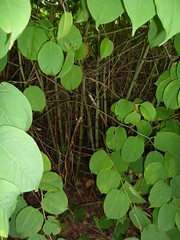

Weedkillers
Roundup Weedkiller concentrate
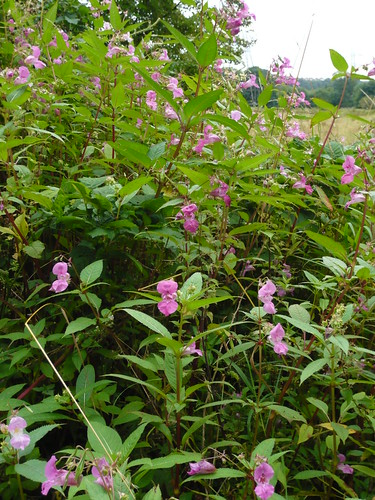
Himalayan balsam is enemy number one at Otley Chevin where this invasive weed is chocking our natural flora. Locals have been recruited to help with ‘Root it Out’ events to stop the spread of these seed propagated plants.
I have has seedlings in my garden as has my badminton partner but fortunately they are easy to up root if you get them before they seed.
Recognising Himalayan Balsam
- Himalayan Balsam is common on river banks with reddish coloured stems and dark green lance shaped leaves with jagged edges.
- The brightly coloured flowers that are usually in variable shades of purplish-pink from June to October up to 6 feet in height.
- The plant is annual and lasts for one year and dies at the end of the growing season.
- Himalayan Balsam can produce around 2,500 seeds in explosive seed pods that throw seeds over 20 feet away from the original plant. The seeds can last in the ground for several years.
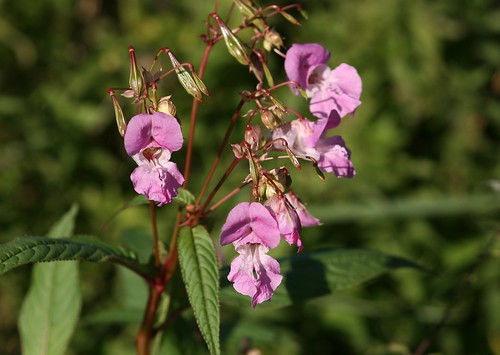
Treatments to Kill Himalayan Balsam
- Do not allow invasive weeds to set seed.
- Pull out the shallow rooted plants as soon as you see them.
- Cut off below the last node near the ground and they shouldn’t regrow.
- Animals can safely graze on the plants.
- Himalayan Balsam should be sprayed in spring before flowering with Gylphosphate based weed killer
Sprayer and Weedol by Amazon
Photo Credits
Himalayan Balsam by Deanster1983 CC BY-ND 2.0
Why do they grow ‘Shamrocks’ in Ireland?
Because St Patrick took all the ‘real rocks’ away so the snakes couldn’t hide.




5 thoughts on “Garden Control of Invasive Weeds”
8.Brambles particularly the hedgerow varieties with very small fruit and thus no redeeming features.
Excuse me??!! No redeeming features? What about the myriad animals that use brambles as a refuge, food source, link through to other habitats and woodland etc. Brambles are one of the MOST useful plants we have in our countryside!
Comments are closed.